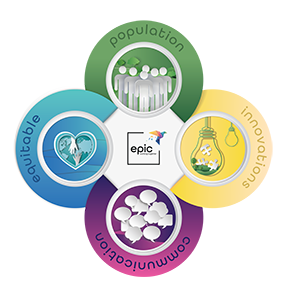What is EPIC about?

EPIC emerged through the realisation that current services are inequitable, inaccessible, and unaffordable for the majority of the South African population – impacting many poor, Black, African language speaking individuals. There was/is a need to expand our practices in ways that are responsive to the needs of our context. Beyond solely focusing on communication disability, we also need to think about how we contribute to address the inequities in our society. In other words, we need to consider how systemic injustices, (i.e. the lack of education, housing, resources, and health care) affect the communication opportunities available for individuals to success. In 2018, Mershen and Harsha published their conceptual paper called “Renewing our cultural borderlands: Equitable, Population-Based Innovations for Communication (EPIC)” which documents the thinking around EPIC and the possibilities for shifting practices.
EPIC stand for:

EQUITY
ALL Languages
Cultures
Religions
Genders
Races

POPULATION
For the greater good
For all
To reach many
Individual
Community
Society

INNOVATION
Thinking out loud
Reimagining
Creativity
Something different, new

COMMUNICATION
Having needs and wants met
Self-expression
A means
All modalities
Listening
Speaking
Reading
Writing
Gesture
Overview of EPIC
Harsha Kathard presented the Keynote presentation at The Royal College Of Speech Language Therapists conference in 2021 entitled: Breaking barriers and building better. In her presentation Harsha speaks about the ways in which speech-language therapists can work toward advancing inclusion in our clinical, research and education practices through expanding our dominant practices.
